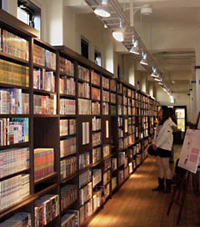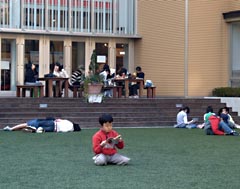 |
Here and There introduces art, artists, galleries and museums around Japan that non-Japanese readers and first-time visitors may find of particular interest. The writer claims no art expertise, just a subjective viewpoint acquired over many years' residence in Japan. |
|
 |
|
|
 |
 |
Zen and the Art of Cartooning: The Kyoto International Manga Museum
Alan Gleason |
|
 |
|
The former Tatsuike Primary School in downtown Kyoto,
now the International Manga Museum.
|
Merely by its location, Kyoto's new International Manga Museum manages to tweak certain stereotypes: it is situated smack in the middle of Japan's ancient capital, better known as a haven of quiet temples and Zen gardens than as a bastion of pop culture; and it occupies a refurbished elementary school whose echoing stairwells and spartan ambience conjure up our own school days, when we snuck comics into class at our peril.
 |
 |
|
Just one part of the Wall of Manga;
this entire floor is devoted to comics for young adults.
|
|
That the world's largest museum devoted solely to manga is in Kyoto of all places is thanks to another of the city's traditions, that of eccentric intellectual pursuits. Kyoto Seika University offered its first academic course in Manga Studies way back in 1973; in 2006 it established a full-fledged Faculty of Manga. Seika U. had a burgeoning manga collection and was running out of room, and the city of Kyoto had an unused elementary school, a sturdy prewar structure closed since 1995. After intense negotiations and extensive renovations, the university and the city collaborated to reopen Tatsuike Primary School as the Manga Museum in the fall of 2006.
It is a big building, and at first it is hard to imagine that a manga museum could put all of it to use. But our guide explained that the museum, which Seika manages for the city, is already hard put to find space for a 200,000-title collection that will reach 300,000 before the year is out. Most of those volumes are kept behind glass in the basement archives; at any given time about 50,000 are placed on shelves upstairs where patrons are free to peruse them as they make the rounds of a Wall of Manga that seems to stretch into infinity. Readers of all ages sprawl in the halls, around tables, and on the lawn where the school playground used to be, utterly engrossed in their favorite works. Indeed, they look a lot more studious than most schoolkids do reading ostensibly more edifying fare.
 |
 |
|
Young readers peruse their favorite manga on the lawn in front of the museum.
|
|
Plopping a manga museum down in the midst of Kyoto's temples and teahouses has proved to be a brilliant tourism gambit for the city. Foreigners in particular love the place; our guide estimated that 15 percent of the museum's patrons are from overseas. Though the focus is on Japanese cartooning, visitors flock to a first-floor shelf devoted to comics from other countries, as well as manga in translation. Rotating exhibits upstairs also feature manga from different countries.
The museum offers long-term exhibitions in its main gallery (the former school auditorium). Recently it produced a retrospective of the entertainment genre known as kamishibai, the "picture plays" performed from the backs of bicycles by itinerant showmen in prewar and postwar Japan, captivating children and earning disapproving grumbles from their parents. The checkered history of kamishibai is a vivid microcosm of the twists and turns of 20th-century Japan through periods of educational reform, military censorship, patriotic propaganda, and postwar democracy. Kamishibai reached its peak during the impoverished, pre-TV fifties; when it began losing its youthful audience to TV, many artists went on to achieve fame drawing manga. Now it is experiencing a bit of a nostalgia-boosted comeback, and the young man who demonstrated the art at the museum, part of a troupe that specializes in reviving kamishibai, delighted his rapt audience with macabre laughter and silly puns as he spun the immortal tale of "Golden Bat." (Visitors can still enjoy daily kamishibai performances even after the current exhibit closes.)
 |
|
A kamishibai performer doing a show at the museum.
(All photos by Alan Gleason; courtesy of the Kyoto International Manga Museum.)
|
|
|
|
|
 |
 |
|
 |
Kyoto International Manga Museum |
 |
|
 |
Karasuma-Oike, Nakagyo-ku, Kyoto |
|
Phone: 075-254-7414
Open 10-8; admission until 7:30 (Closed Wednesdays and New Year holidays)
Transportation: 1-minute walk from Karasuma Oike station on the Karasuma and Tozai Subway Lines |
 |
|
 |
 |
Alan Gleason
Alan Gleason is a translator, editor and writer based in Tokyo, where he has lived for 24 years. In addition to writing about the Japanese art scene he has edited and translated works on Japanese theater (from kabuki to the avant-garde) and music (both traditional and contemporary). |
|
|
|
 |
 |
|